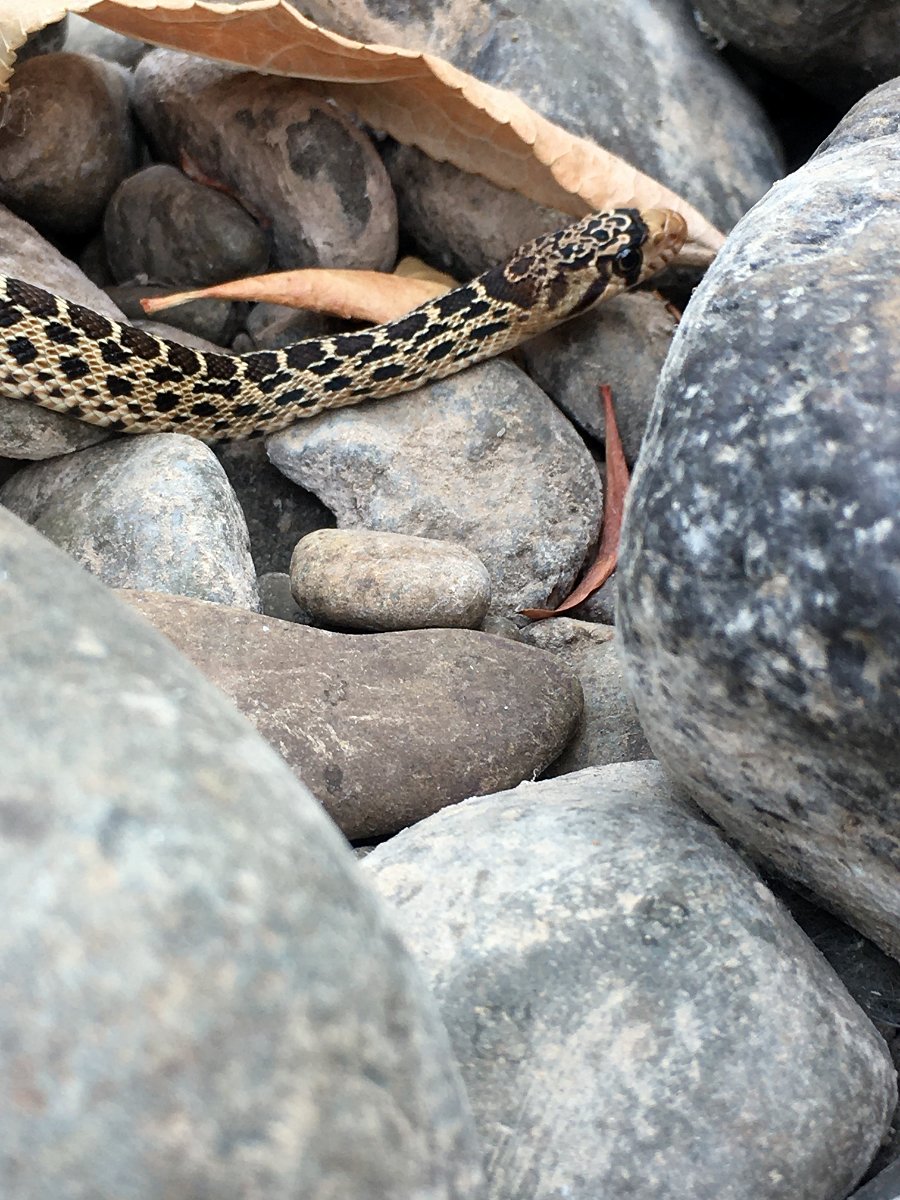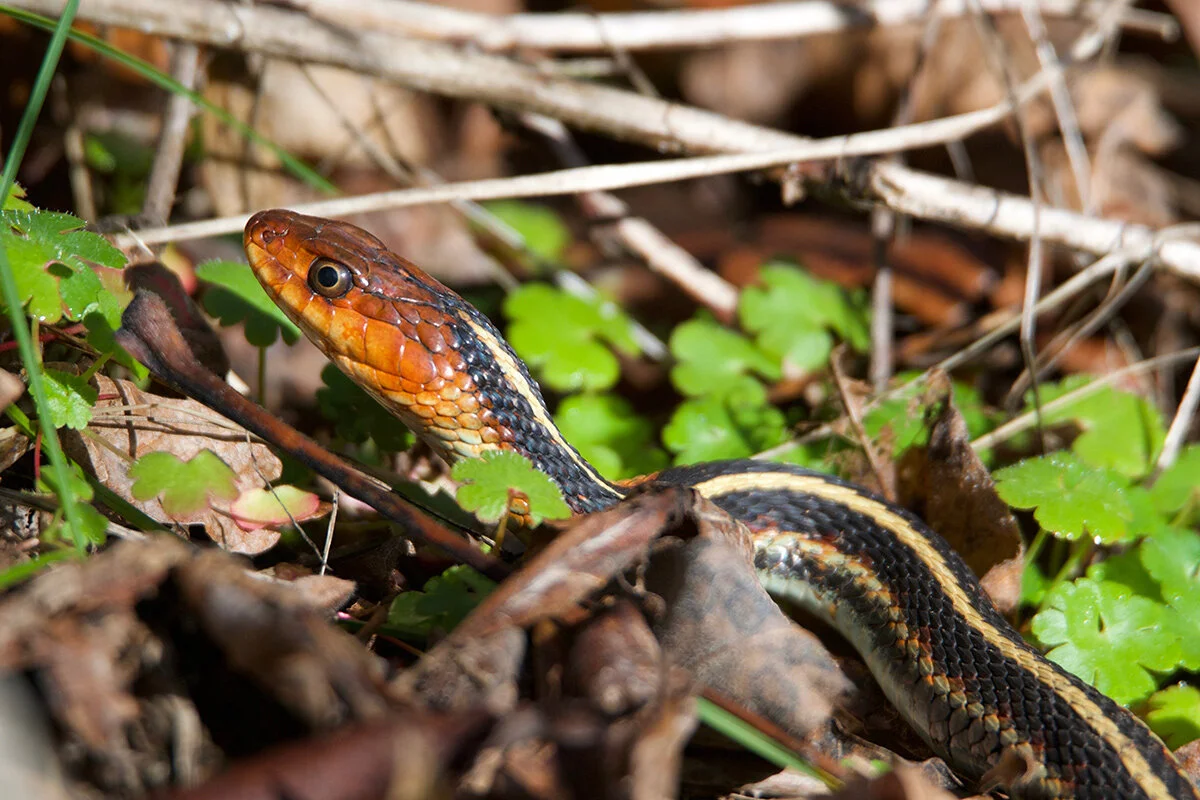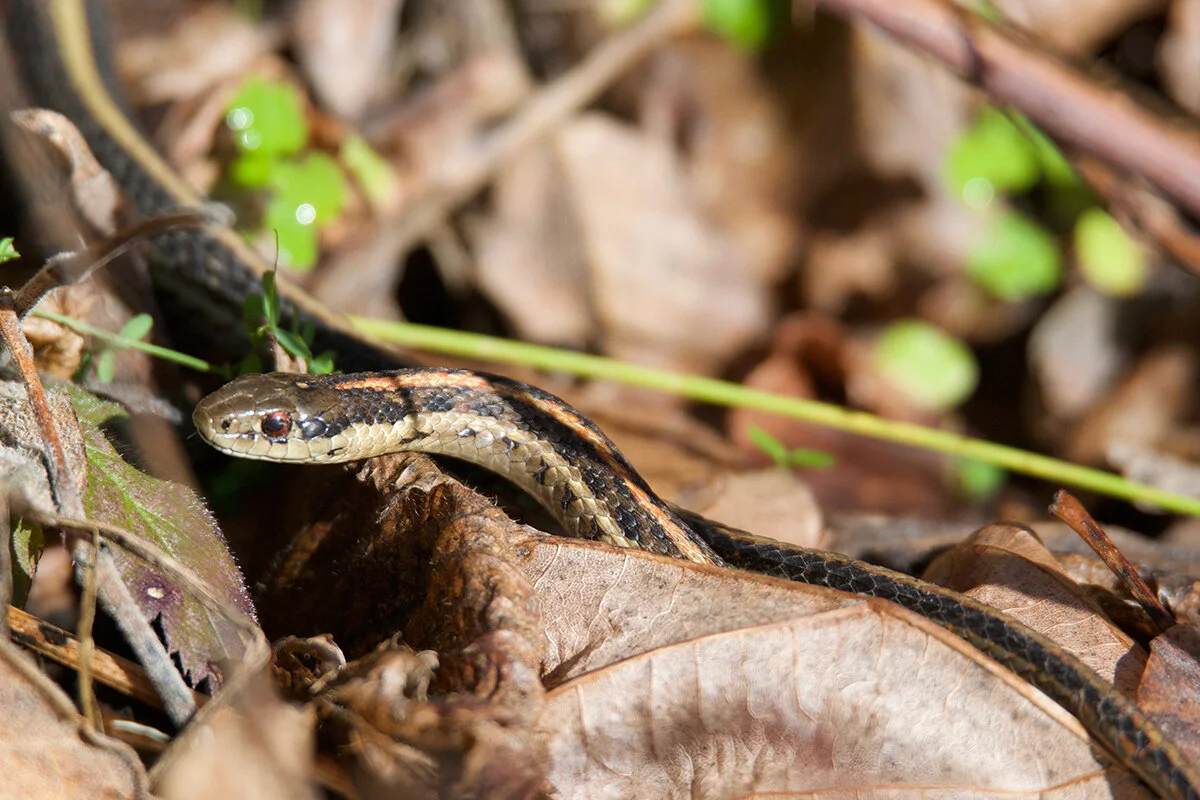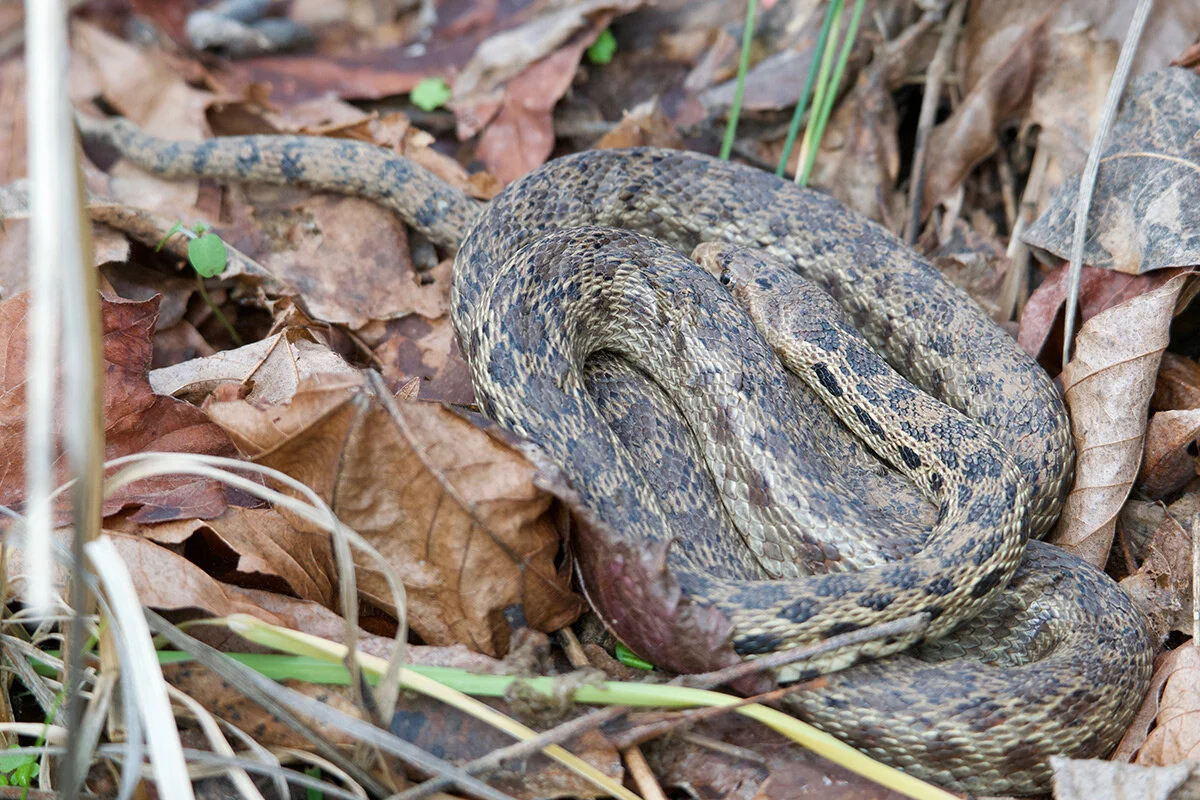On Sunday, members of the habitat committee at the arboretum went looking for amphibian egg masses. We waded around in the wetlands for a couple of hours and weren’t able to find any out there yet. The water level is fairly high at the moment from all of the recent rain, so we weren’t able to survey all of the locations that we wanted. Also, there are heaps of fallen tree limbs clogging the area from last year’s ice storm. That said, we were able to find egg masses of the Pacific Treefrog in the shallow pools around the parking lot. It will be interesting to see how viable these eggs are this early in the year and when they might hatch during the cold, winter weather. As friendly reminder to help protect these creatures, please remember to keep your dogs and children out of the shallow pools found throughout the arboretum like around the parking lot and the area known as The Seeps along the road that goes above the wetlands. Thank you. As the evening approached, the males started vocalizing their beautiful choral croaks, music to my ears. Spring is on its way!
Gopher Snakes & Western Fence Lizards
Here are some more notes from wandering along the river. I have been seeing many small Western Fence Lizards. I see them basking on the rocks, leaping between rocks, and looking around and underneath rocks. They are curiously exploring their world. I imagine their bodies find it thrilling to feel all of the different textures of the rocks—gritty, smooth, bumpy, etc. They must be acutely tuned into all the different temperatures of the rock’s surfaces from the hot tops in the sun to the cool bottoms next to the damp ground and every thermal reading in between.
Another animal that is keenly tuned into its surroundings is the gopher snake. It was quietly moving in and out of the rocks and through the willows. I imagine it was aware of all the scurrying lizards and was looking for a meal. Its diet includes insects, lizards, rodents, birds, and bird eggs. Gopher snakes are constrictors. I watched it for a little while hoping to witness it capturing its prey but didn’t have any luck.
Western Yellow-bellied Racer
I was walking around to get a better view of a white-breasted nuthatch nest site when I came across this snake sunning itself in this small depression. I was pleased that it allowed me to take a couple of photos and check it out. I have had brief encounters with this snake before as it slid off into the grass, but haven’t really got a good look at one. As the name Racer suggests, this snake is able to slither away at 3.5 miles per hour, which is a pretty fast walking speed.
Contrary to what its Latin name Coluber constrictor mormon suggests, this snake does not kill its prey with constriction. It is a non-venomous snake that captures its prey in its mouth or pins it to the ground and then swallows it alive. Its diet consists of a variety of animals such as small mammals, insects, lizards, snakes, and frogs.
When alarmed, racers will try to imitate rattlesnakes by vibrating their tail and rattling leaves. I read that they can be quite aggressive if approached and they feel threatened or if you try to pick one up. They will bite, defecate, and discharge foul-smelling musk in an attempt to be released.
I didn’t see that it had a yellow belly but read that the color can range from off-white to yellow. I like its nice brown, earth-tone color with a pale, sky-blue wash on its side.
Pacific Tree Frog
Pacific tree frogs will even seek these small, shallow pools of water in the parking lot to mate and lay their eggs. For such a small creature, they have powerful vocalizations that are amplified by passing air into the frog's vocal sacs. These sacs expand from the floor of the mouth to create a chamber that enhances/resounds their mating call.
I want to expand this breeding area by blocking off the end of the parking area. The frogs like this area because it is fed by a small flow of rainwater that slowly seeps into the ditch. One of the biggest challenges that humans face is setting aside habitats for nature for it to live and thrive. It is paramount for our own survival.
Western Fence Lizard
Meet the Western Fence Lizard. It has radiant blue patches on its sides and the undersurfaces of its legs are yellowish-orange. The adult male has a blue patch on the throat. This lizard can range in color from olive, brownish, or black. It can have a pattern of paired blotches, wavy crossbars down the back, or occasionally some striping.
I have been seeing this beautiful creature on dead snags, stumps, the bases of oak trees, and the small wooden bridges throughout the arboretum. These places allow it to regulate its body temperature and blend into its surroundings as it hunts for prey.
Its diet consists mostly of insects and some spiders. I saw this one eating ants that were crawling around on the stump.
The Western fence lizard is also in the diet of other animals. To escape from predators, it can miraculously shed part of its tail. The dropped tail will wriggle like a living creature, which allows the lizard to escape while the predator is trying to catch the detached tail. The tail usually regrows in 3 to 5 weeks, is never identical to the original, and is almost always shorter.
The male is often seen displaying when it is defending its territory or trying to attract a potential mate. It will flatten its sides to show its blue patches and quickly does up and down movements with its front limbs that look like “push-ups.”
If its radiant blue doesn’t get your attention, this next bit of information that I found on the website of the National Science Foundation might. It states that “In the Western region of the U.S., the Western black-legged tick, or Ixodes pacificus, is the primary vector for Lyme disease bacteria. Up to 90 percent of the juvenile ticks in this species feed on the blood of the Western fence lizard, common in California and nearby states. A previous study by UC-Berkeley entomologist Robert Lane found that a protein in the Western fence lizard's blood killed Borrelia bacteria, and as a result, Lyme-infected ticks that feed on the lizard's blood are cleansed of the disease-causing pathogen.”
Researchers wanted to further test the Western fence lizard’s role in the Lyme disease ecology. They relocated the Western fence lizard from test areas and found “that 95 percent of the ticks that no longer had lizard blood to feast on failed to latch onto another host.” That certainly makes things more complex and interesting. The Western fence lizard both kills the bacteria that causes Lyme disease and also supports a huge population of ticks.
Nature is composed of many interconnected parts, and it can be difficult to see how it all functions together. What I do know for sure is that nature will always be an endless source of wonder, discovery, and learning.
Hope to see you out there.
References
Behler, John L., and F. Wayne King. The Audubon Society Field Guide to North American Reptiles and Amphibians. A Chanticleer Press ed, Knopf: Distributed by Random House, 1979.
Numbers of Lyme Disease-Carrying Ticks Plummet in Absence of Western Lizards. https://www.nsf.gov/news/news_summ.jsp?cntn_id=118655. Accessed 23 June 2022.
Western Fence Lizard. https://friendsofedgewood.org/western-fence-lizard. Accessed 23 June 2022.
Ring-necked Snake
I wanted to see one of these this summer, and I was pleasantly surprised to find one resting for a moment on the trail the other day.
This snake has a beautiful two-toned coloration. It is slate gray to green above. On its underside and a small ring just behind its head is a striking bright reddish-orange or yellow. When disturbed, it coils the tail upward to reveal the bright underside as a defense strategy to deter a predator. Colors such as red, yellow, and orange are often associated with venomous species. In addition, this flash of color can be used to temporarily confuse a predator while it makes it escape.
On the Oregon Department of Fish and Wildlife (ODFW) website, it had the following to say about the ring-necked snake:
“The ringneck snake requires moist micro-habitats such as downed logs, rocks, or stumps. It is found in a variety of vegetation types, but is most closely associated with pine-oak woodlands and moist canyon bottoms. It also can be abundant in Willamette Valley grasslands.
These snakes feed mainly on small lizards, snakes and salamanders and also slugs, earthworms, frogs, and insects.”
References
ODFW website - snakes
ODFW Living with Wildlife - Snakes
Pacific Tree Frog Eggs
There are small, shallow pools in the lower parking lot. The Pacific tree frogs love to lay their eggs in the sunny, warm puddles. It is the perfect nursery. Algae grow in the pools for the tadpoles to eat, and they have places to seek shelter under leaves and other vegetation.
If you are lucky, you might see one of the tree frogs in or around the water. It is a small frog measuring from ¾ to 2 inches. It varies in color from green to light tan and has a distinctive black or dark brown stripe through the eye. It also has notable, large toe pads.
Frogs are very susceptible to pollution. So it is interesting to see them successfully using these pools in the parking lot. The runoff of grease, oil, etc., must be minimal at this end of the lot.
I’d like to give a friendly public service announcement. Please remember to keep dogs out of these pools and the seeps along the quarry road. Along with frogs, they are filled with many fragile creatures.
Northwestern Salamander Eggs
Out in the wetlands, northwestern salamanders have been laying their eggs. The eggs are encased in a gelatinous mass that is roughly the size of a small grapefruit. They are attached underwater to small branches, grass, or other aquatic plants.
The eggs hatch in 2 to 9 weeks. During that time, algae will start to grow inside mass which provides them with oxygen. When the larvae hatch from eggs they swim using a tail fin and breathe with filamentous, external gills. When the larvae mature, they usually transform into salamanders that live on land. That said, Northwestern salamanders can develop into neotenic adults. This means that they stay in the water throughout their lives and retain their gills and finned tails. This phenomenon is seen more in higher altitudes.
The terrestrial adults spend much of their lives in moist places underground. They stay in and under rotten logs and often utilize the tunnels of burrowing mammals such as moles. This is probably why I don’t see them. I have only seen one out in the wetlands, and it was being eaten by a red-spotted garter snake.
There are bullfrogs out in the wetlands, and I was worried they might eat the salamanders. I was relieved to read that the larvae and terrestrial adults are mildly poisonous, so they can generally survive alongside predatory species, such as bullfrogs. Hopefully, the eggs will be safe. Perhaps they hatch out before bullfrogs are very active.
Bullfrogs
Bulbous, bumpy, bellowing, beautiful bullfrogs are out sunning themselves in the wetlands at the bridge.
They are 3.5 - 8 inches long, and they are the largest frog in North America. They have a large tympanum (eardrum) located just behind the eye. A ridge goes from the eye, around the eardrum and down towards the front leg. They have no dorsolateral ridges. They have a deep-pitched mating call that sounds like jug o’rum. Their diet includes fish, amphibians, birds, reptiles, small mammals and insects.
Bullfrog tadpoles are large at 4 - 6.75 inches, and their metamorphosis may take up to two years.
They were introduced to the western United States. Their natural range is east of the Rockies where they have natural predators to keep them in check. Oregon Dept. of Fish and Wildlife (ODFW) lists them as an invasive species that adversely affect native populations by devouring native turtles and frogs. ODFW also says that “bullfrogs can lay up 20,000 eggs each season while native species such as red-legged frogs lay up to 5,000 eggs.”
Red-legged Frog
I was slowly walking along the zig-zag trail the other evening. I heard a slight rustling and saw a garter snake gently flowing through the green carpet of plants along the path. A moment later, this little frog popped out in front of me. It turned and started hopping away. I’m sure it sensed the snake’s presence. I took a couple of photos as it made its escape. Not wanting to add any stress to a tense situation, I moved on hoping it made it to a safer location.
Amphibian is a Greek word. Amphi means “of both kinds" and bios means "life." An amphibian’s life cycle usually starts off in an aquatic environment and moves to a terrestrial one upon maturity. Frogs began their life in water as tadpoles and move onto land as an adult. That said, frogs usually don’t venture to far from water because their skin needs to stay moist. Most amphibians breathe through their lungs and their skin. So their skin needs to stay moist in order to absorb oxygen. Fascinating!
Since the health of a frog’s skin is crucial to its survival, it is very sensitive to its environment. For this reason, frogs are considered indicator species — their presence or absence can tell us about the health of an ecosystem. Unfortunately, we have seen the decline or extinction of frog species throughout the world. It’s a warning that we need to be better caretakers of nature!
I hope you read more about frogs. Their lives are an absorbing topic.
Red-legged Frog (Rana aurora)
Solstice Snakes
In my walk around the arboretum today, I came across a bank where a few snakes were soaking up the warmth of the sun. I initially paused in this spot to watch a mixed flock of song birds that were moving through the landscape foraging insects. I heard a slight rustle in the leaves and looked down to find the vibrant head of a red-spotted garter snake glowing like a burning coal. The day felt so calm, and I hoped for peace in the coming year.
There were a couple of other garter snakes moving through the leaves, and a gopher snake was curled up nearby. What beautiful, mysterious creatures they are!
Pacific Gopher Snake
I love the crisp, cool mornings and the warm, sunny afternoons of early fall. As I was walking along the river path, I came across another creature enjoying the warmth of the sun - the Pacific Gopher Snake. I’ve read that they get their name from using gopher borrows as habitat. That said, they will eat gophers, other small mammals, birds, and lizards. Gopher snakes are constrictors and nonvenomous. To scare off predators, they will mimic a rattlesnake by coiling, hissing, striking, and vibrating their tails.
Earlier in the summer, I heard the mild agitation call of a robin, and when I went to take a closer look, I saw a Pacific Gopher snake climbing a tree.
Click on photo to enlarge.
Garter Snake Mealtime
I was walking down the trail and a little flash caught my eye. It was a Bewick’s wren flitting through the tangled vegetation along the ground. As I was standing there watching it maneuver through the branches, I heard a gentle rustle on the other side of the trail. I took a few steps forward and saw a red-spotted garter snake backing out from underneath some leaves. As its head came out from under the leaves, I saw that it was eating a rough-skinned newt. The snake would move backward and then with a slight push forward it would swallow a little more of the newt. After it swallowed the newt, it stretched out in the dappled sunlight and rested. I watched for about 5 minutes and decided to move on to let it digest its meal in peace. I was grateful to have witnessed the event and to get a few photos.











































